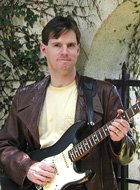Hi Barrett,
Can you guide me a little regarding controlling distortion?
Actually I find it almost impossible to play with distortion, except when playing power chords. When I try to play a few lead notes (melody) the distortion just becomes uncontrollable and it sounds really very bad. It's like the notes sound bad together with each other (when they mix or sound together).
I really want to practice a few leads, scales, etc., with distortion to learn to play a bit of rock and metal, but I just can't figure out what to do. I tried to mute every note before going to the next note, but it sounds very 'broken" and non-continuous.
How do people play such beautiful and smooth solos with distortion ?
Thanks.
Try this experiment. On your distorted electric guitar I want you to wrap a soft hand towel or a big tube sock around the first few frets of the neck. It should be tightened just enough to completely damp the sound of the strings. If you strum this guitar, it will just go "thunk" and then stop.
Now try playing on the frets above this "damper." If your playing sounds much better than it did before, then you need to work on damping the unwanted noises with your fretting-hand fingers and your picking-hand palm. Instead of completely damping each note before moving on, you should practice an overall mentality of keeping a close grip in either hand, where you are almost muting the note that you are actually playing (or maybe even so that you are muting it, a little) so that all the other strings are definitely damped.
If, on the other hand, it still sounds pretty messy even with the cloth there, then you may have a problem with the number of strings you are pressing down at the same time, or picking accuracy. Practice slowly, making sure that you're lifting your finger off one string just as you depress another, and that you're only picking the one string at a time that you want. Eventually this will become a habit, and you'll have cleaner execution without thinking too much about it.
It is also possible that you are simply using too much distortion. Many beginning players use more than is needed. Try setting it so that a cleanly played note stays at the same apparent volume for about 3 or 4 seconds before it starts to decay; in other words, about twice the subjective amount of sustain as your clean tone.
Try turning down the tone control on the guitar itself. The more "in your face" (bright and trebly) the tone is, the more details in the guitar's sound will be heard, including finger noise, fret noise, and incidentally-sounding strings.
I often play leads with my tone control set at nearly zero when I'm forced to use a solid state amp with a built-in lead channel. There are also many possibilities for improving the tone by turning down the volume knob on the guitar itself. It does many more things than just make it quieter or louder. Depending on the pickups you are using, restricting the guitar's dynamic range by lowering the volume knob can act as a sort of compressor, again smoothing out the sound. Compensate by adding a little more gain at a later stage, like on your distortion pedal.
Finally, consider that your guitar sound is going to be eventually fit into an overall mix that includes drums, bass, and maybe another guitar or keyboard part. While I do recommend learning to play cleanly as possible, a _small_ amount of extraneous guitar noise will not stick out as much in that situation as it does when the guitar is listened to alone.
Barrett

Sunday, April 22, 2007
Subscribe to:
Post Comments (Atom)
Barrett Tagliarino

No comments:
Post a Comment